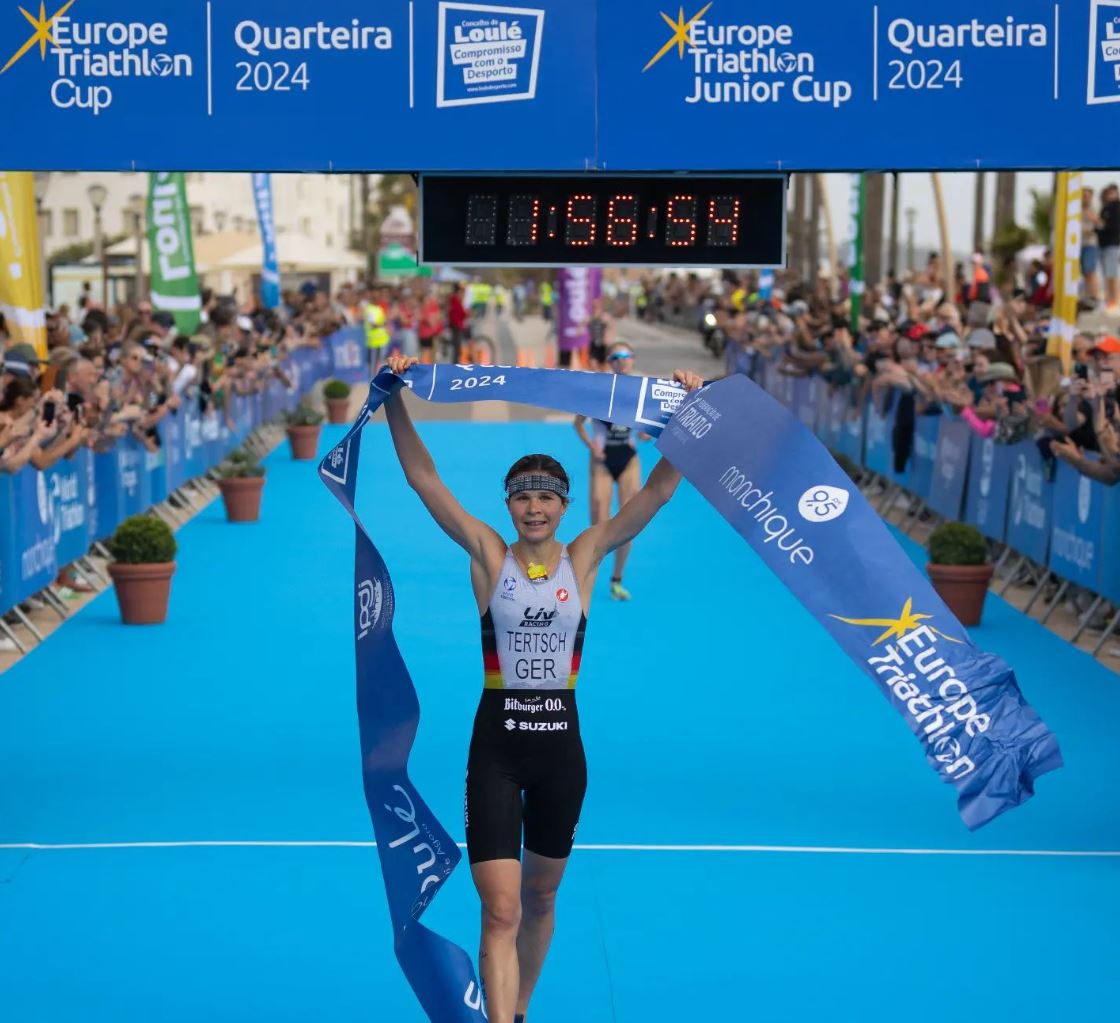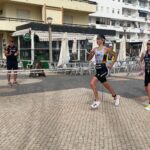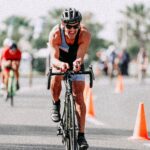Imagine what it’s like to be a professional triathlete. Everyone is genetically gifted, all use the latest fitness testing and training technology, all are in incredible physical condition, all fuel and hydrate scientifically, ![]() all have fast bikes and fast shoes. So, on race day, what separates the winners from the also-rans? Two key things, I believe. First, the ones who can harness the power of their minds to propel them to the finish in the face of fatigue and pain. Second, the ones who can squeeze every small time advantage out of themselves and, you may not have thought of this, the course (what are lovingly called in our sport, marginal gains).
all have fast bikes and fast shoes. So, on race day, what separates the winners from the also-rans? Two key things, I believe. First, the ones who can harness the power of their minds to propel them to the finish in the face of fatigue and pain. Second, the ones who can squeeze every small time advantage out of themselves and, you may not have thought of this, the course (what are lovingly called in our sport, marginal gains).
As an age grouper, if you participate in triathlon for the fun, health benefits, and community, this article may not be of interest to you. But if you race to compete and to test yourself against the best in your age group (I sure do!), then you can likely pick up some crucial marginal gains (and vital seconds and minutes, depending on the distance) from what I have to share. Because, whether you’re a pro or an age grouper, races can be won or lost by seconds. Personal case in point: I won the bronze medal at the 2023 World Super-sprint Championships in Spain last fall by less than a second!
depending on the distance) from what I have to share. Because, whether you’re a pro or an age grouper, races can be won or lost by seconds. Personal case in point: I won the bronze medal at the 2023 World Super-sprint Championships in Spain last fall by less than a second!
Referring to three of the pro triathletes I work with, Ruth Astle just spent nine days in Nice, France ![]() reviewing the courses in preparation for the Ironman World Championships this fall. Lisa Tertsch has already raced the Paris Olympic course several times but will still be returning Paris in the next few months to get even more familiar with the courses. Both (as well as Miguel Mattox as he returns to racing after his injury) will continue to hone their course-recon skills at upcoming races, all in preparation for their “A” races later this season.
reviewing the courses in preparation for the Ironman World Championships this fall. Lisa Tertsch has already raced the Paris Olympic course several times but will still be returning Paris in the next few months to get even more familiar with the courses. Both (as well as Miguel Mattox as he returns to racing after his injury) will continue to hone their course-recon skills at upcoming races, all in preparation for their “A” races later this season.
Oh, one thing to remember is that this process doesn’t just mean swim, bike, and run familiarization. Many triathletes forget that there are two other “events” in a triathlon, namely, T1 and T2, both of which are crucial to triathlon success, particularly for short-course racing. Personal case in point: I’ve made my transitions a focus the last few years and I have regularly beaten close competitors because I pick up substantial amounts of time in T1 and T2.
are crucial to triathlon success, particularly for short-course racing. Personal case in point: I’ve made my transitions a focus the last few years and I have regularly beaten close competitors because I pick up substantial amounts of time in T1 and T2.
There are many details that impact your ability to swim, bike, and run your fastest (as well as transition your fastest).
Swim
Swim familiarization is so important because it is the one part of triathlon that has so many variables that  are outside of our control and that is the most anxiety provoking for most triathletes. The more you know, the more in control you will be, and, in turn, the more confidence and comfortable you will feel. Some of these critical parts of swimming that can come from a comprehensive course familiarization include:
are outside of our control and that is the most anxiety provoking for most triathletes. The more you know, the more in control you will be, and, in turn, the more confidence and comfortable you will feel. Some of these critical parts of swimming that can come from a comprehensive course familiarization include:
- Water temperature and anticipated water conditions (warm/cold, rough/smooth).
- Tides or currents.
- Number of competitors.
- Direction of the swim.
- Number of laps.
- Buoy placement and sighting.

- Location of the sun (and how it impacts sighting).
- Entry and exit.
- Start format (mass, rolling, by age-group, in water, from dock, run from beach, diving allowed).
- Start position (front/back, left/center/right).
- Route to T1.
Additionally, if the race offers a swim familiarization, you have a great opportunity to:
- Get used to the water temperature and surface conditions.
- Practice your start and exit.
- Orient your buoy sighting.
- Rehearse your swim tactics and pacing.
- Check that your goggles are clean, fog-free, and not leaking.
- If you will be wearing a wetsuit for the race, practice stripping it as fast as possible.
T1
In some ways, transitions are the most complicated aspect of a triathlon and T1 is particularly so because  you are always wet, often cold, frequently need to strip off your wetsuit (an awkward experience under even ideal conditions). Your ability to move swiftly through T1 often comes down to familiarity and practice. Here are some key data you should collect related to T1:
you are always wet, often cold, frequently need to strip off your wetsuit (an awkward experience under even ideal conditions). Your ability to move swiftly through T1 often comes down to familiarity and practice. Here are some key data you should collect related to T1:
- Distance from Swim Out.
- Running surface from Swim Out.
- Terrain from Swim Out.
- Your transition location.
- Transition area row markers and numbers.

- Layout of your transition area.
- Distance to Bike Out.
- Running surface to Bike Out.
- Terrain to Bike Out.
- Location of bike mount line.
Bike
The bike leg of a triathlon is the part of triathlon where there are so many challenges (e.g.., strong winds,  climbing, descending, turns, hydrating, and fueling) and where so many things can go wrong (mechanical problems, getting lost, crashing, and, on courses that are open to traffic, getting hit by a car). Here are some important data points you will want to know:
climbing, descending, turns, hydrating, and fueling) and where so many things can go wrong (mechanical problems, getting lost, crashing, and, on courses that are open to traffic, getting hit by a car). Here are some important data points you will want to know:
- Course route.
- Number of laps.
- Expected weather (temperature, clear/rain).
- Expected wind direction.

- Road surface.
- Climbs and descents.
- When and where to fuel and hydrate.
- Location of aid stations.
- Exit of T1 and entry of T2.
T2
T2 is mostly the same as T1, though simpler in some ways because you’re going from the more complex experience of cycling to the simpler experience of running.
- Running surface from Bike In.
- Terrain from Bike In.
- Your transition location.
- Transition area row markers and numbers.
- Layout of your transition area.
- Distance to Run Out.
- Running surface to Run Out.
- Terrain to Run Out.
- Location of Run Out.
Run
Regardless of the distance of your triathlon, knowing the run course is essential for several reasons. First,  how your run goes will ultimately determine how your race goes. Second, you’ll be tired at this point, so it will be harder to focus on the course. Third, because many races have laps on the run, you have to pay attention to how far you’ve run. To nail your run, here are some things to get familiar with:
how your run goes will ultimately determine how your race goes. Second, you’ll be tired at this point, so it will be harder to focus on the course. Third, because many races have laps on the run, you have to pay attention to how far you’ve run. To nail your run, here are some things to get familiar with:
For the run:
- Course route.
- Number of laps.
- Expected weather (temperature, sunny/rain).
- Expected wind direction.
- Uphills and downhills.
- Turns (particularly 180s).
- Curbs (so you don’t trip and fall).
- Running surface.
- When and where to fuel and hydrate.
- Location of aid stations.
- Entry and length of finish shoot.
As we have seen at every distance of triathlon, races can come down to seconds. At the same time, if you leverage every marginal gain to your advantage through a thorough course familiarization, as races get longer, those marginal gains can add up to substantial chunks of time. By doing your “homework” before races, you not only maximize those marginal gains, but, psychologically, you also make additional gains in motivation, confidence, focus, and calm, knowing you understand what it will take to have your best race possible.







